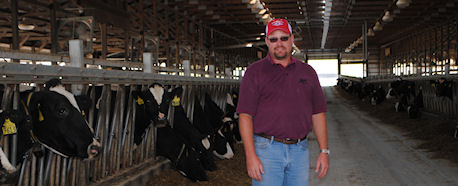
Last summer, Steve Abel, co-owner of Abel Dairy Farms, Eden, was looking for a better way to detect when his 1,500 cows and 1,350 heifers were in heat. He also wanted to determine when a cow was sick with mastitis, a displaced abomasum or ketosis or other ailment and to know if a cow was eating or not.
The solution
After meeting with representatives from East Central/Select Sires and SCR, Abel chose to purchase the SCR Heatime HR-LD System which monitors cows' rumination and activity. Each cow wears a collar that transmits activity and rumination data from anywhere on the farm a few times every hour. The system provides real-time health monitoring and up-to-date heat detection reports.
"We could have just purchased the collars for the cows that we were trying to get bred, but we decided with the ability to monitor rumination as well as activity, we wanted them on all of the cows. We also use them on our heifers 11 months on up," Abel explains.
Cows at Abel Dairy Farms average 95 pounds of milk per cow per day which translates into a 31,000 pound herd average. Sweating the small stuff and paying close attention to detail is important to Abel and his herd managers.
Since installing the Heatime system in August, Abel and his herd managers have already noticed a number of benefits of the system including:
*Much easier to detect heats in heifers.
*Reproductive drug costs reduced by 66%.
*Less days in milk.
*Herd managers no longer need to take daily temperatures on every fresh cow.
*Earlier detection of cows with DAs or mastitis allows for earlier treatment leading to reduced negative impact on milk production.
"It's teaching us to look at cows better and see what we're missing," explains Greg Costello, herd manager. "We're finding sick cows up to a half day earlier than before we started using the monitoring system."
Cutting-edge technology
Abel also likes that the Heatime software has the ability to send an email to his AI technician's smart phone to let him know if he needs to stop again at the farm before he goes home.
"If the breeding list matches the list from the morning then he doesn't need to stop. If there are a couple new cows on the list then he knows to stop," Abel explains.
Abel says there are a number of things that he likes about the Heatime system.
"One thing that it does that we couldn't do before is tell us if a cow is eating," he says. "Since we had our cows in stanchions back in the '90s, we haven't been able to tell if a cow is eating or if she is eating more than she ate the day before. Now we know. Another thing is you can tell if a cow is not active and not eating, then she is sick."
Information is emailed once a week from the Heatime System to Abel Dairy Farms' nutritionist.so he can see what the group averages are for cows.
Abel says the system has revealed some surprises.
"I expected my dry cows to ruminate a lot less than the milk cows," he says. "The opposite is true. They ruminate more."
Abel estimates the payback for Heatime system is about 2½ years.
"With reduced ov-synch costs, earlier detection of sick cows and easier heat detection it may be even less time than that," he says.
For more information about SCR Heatime HR-LD System, contact Tom Breunig, SCR North American Manager at 608-260-5218 or Phil Dieter, reproductive solutions specialist at East Central/Select Sires at 920- 324-3505.
About the Author(s)
You May Also Like






